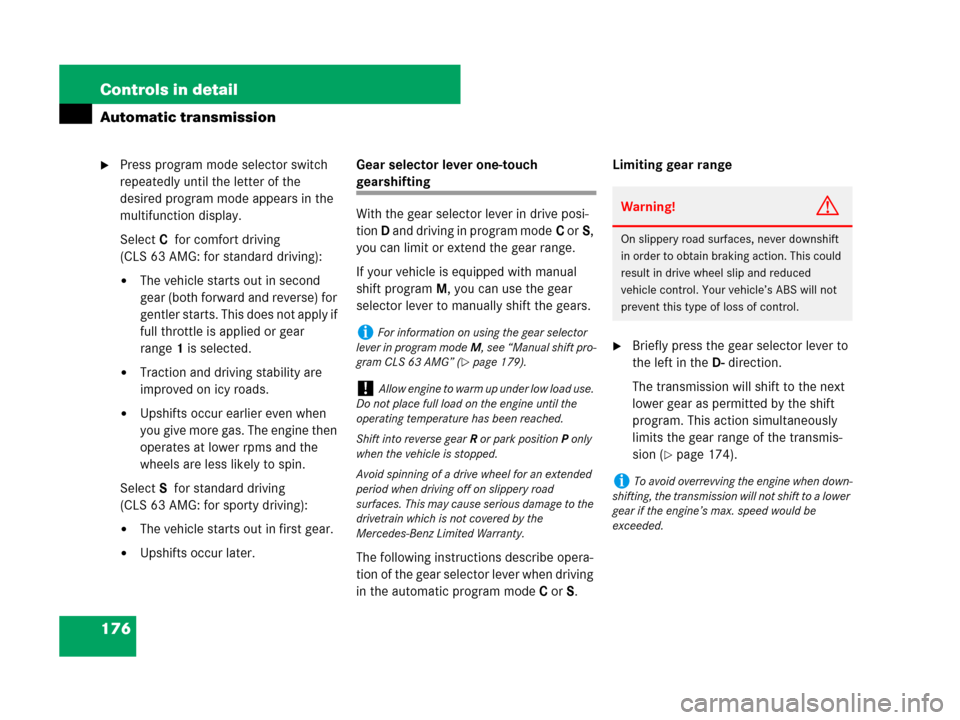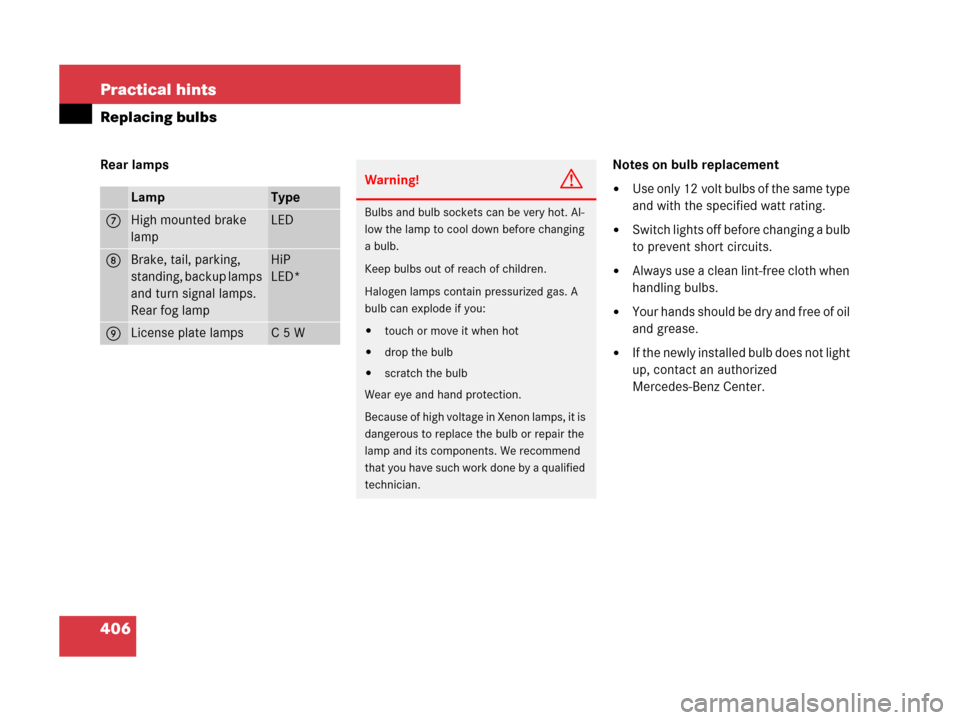Page 177 of 481

176 Controls in detail
Automatic transmission
�Press program mode selector switch
repeatedly until the letter of the
desired program mode appears in the
multifunction display.
SelectCfor comfort driving
(CLS 63 AMG: for standard driving):
�The vehicle starts out in second
gear (both forward and reverse) for
gentler starts. This does not apply if
full throttle is applied or gear
range1 is selected.
�Traction and driving stability are
improved on icy roads.
�Upshifts occur earlier even when
you give more gas. The engine then
operates at lower rpms and the
wheels are less likely to spin.
SelectSfor standard driving
(CLS 63 AMG: for sporty driving):
�The vehicle starts out in first gear.
�Upshifts occur later.Gear selector lever one-touch
gearshifting
With the gear selector lever in drive posi-
tion D and driving in program modeC orS,
you can limit or extend the gear range.
If your vehicle is equipped with manual
shift programM, you can use the gear
selector lever to manually shift the gears.
The following instructions describe opera-
tion of the gear selector lever when driving
in the automatic program modeC orS.Limiting gear range
�Briefly press the gear selector lever to
the left in theD-direction.
The transmission will shift to the next
lower gear as permitted by the shift
program. This action simultaneously
limits the gear range of the transmis-
sion (
�page 174).
iFor information on using the gear selector
lever in program modeM, see “Manual shift pro-
gram CLS 63 AMG” (
�page 179).
!Allow engine to warm up under low load use.
Do not place full load on the engine until the
operating temperature has been reached.
Shift into reverse gearR or park positionP only
when the vehicle is stopped.
Avoid spinning of a drive wheel for an extended
period when driving off on slippery road
surfaces. This may cause serious damage to the
drivetrain which is not covered by the
Mercedes-Benz Limited Warranty.
Warning!G
On slippery road surfaces, never downshift
in order to obtain braking action. This could
result in drive wheel slip and reduced
vehicle control. Your vehicle’s ABS will not
prevent this type of loss of control.
iTo avoid overrevving the engine when down-
shifting, the transmission will not shift to a lower
gear if the engine’s max. speed would be
exceeded.
Page 282 of 481

281 Operation
Driving instructions
Catalytic converter
Your Mercedes-Benz is equipped with
monolithic-type catalytic converters, an
important element in conjunction with the
oxygen sensors to achieve substantial
control of the pollutants in the exhaust
emissions. Keep your vehicle in proper
operating condition by following our rec-
ommended maintenance instructions as
outlined in your Maintenance Booklet.
Emission control
Certain parts of the engine and the emis-
sion control system serve to keep the toxic
components of the exhaust gases within
permissible limits required by law.
These systems will function properly only
when maintained strictly according to fac-
tory specifications. Any adjustments on
the engine should, therefore, be carried
out only by qualified Mercedes-Benz Cen-
ter authorized technicians.Engine adjustments should not be altered
in any way. Moreover, the specified service
procedures must be carried out regularly
according to Mercedes-Benz servicing
requirements. For details refer to the
Maintenance Booklet.
!To prevent damage to the catalytic convert-
ers, only use premium unleaded gasoline in this
vehicle.
Any noticeable irregularities in engine operation
should be repaired promptly. Otherwise, exces-
sive unburned fuel may reach the catalytic con-
verter, causing it to overheat, which could
potentially start a fire.
Warning!G
As with any vehicle, do not idle, park or
operate this vehicle in areas where combus-
tible materials such as grass, hay or leaves
can come into contact with the hot exhaust
system, as these materials could be ignited
and cause a vehicle fire.
Warning!G
Inhalation of exhaust gas is hazardous to
your health. All exhaust gas contains carbon
monoxide (CO), and inhaling it can cause un-
consciousness and possible death.
Do not run the engine in confined areas
(such as a garage) which are not properly
ventilated. If you think that exhaust gas
fumes are entering the vehicle while driving,
have the cause determined and corrected
immediately. If you must drive under these
conditions, drive only with at least one win-
dow fully open at all times.
Page 407 of 481

406 Practical hints
Replacing bulbs
Rear lamps Notes on bulb replacement
�Use only 12 volt bulbs of the same type
and with the specified watt rating.
�Switch lights off before changing a bulb
to prevent short circuits.
�Always use a clean lint-free cloth when
handling bulbs.
�Your hands should be dry and free of oil
and grease.
�If the newly installed bulb does not light
up, contact an authorized
Mercedes-Benz Center.
LampType
7High mounted brake
lampLED
8 Brake, tail, parking,
standing, backup lamps
and turn signal lamps.
Rear fog lampHiP
LED*
9License plate lampsC5W
Warning!G
Bulbs and bulb sockets can be very hot. Al-
low the lamp to cool down before changing
a bulb.
Keep bulbs out of reach of children.
Halogen lamps contain pressurized gas. A
bulb can explode if you:
�touch or move it when hot
�drop the bulb
�scratch the bulb
Wear eye and hand protection.
Because of high voltage in Xenon lamps, it is
dangerous to replace the bulb or repair the
lamp and its components. We recommend
that you have such work done by a qualified
technician.